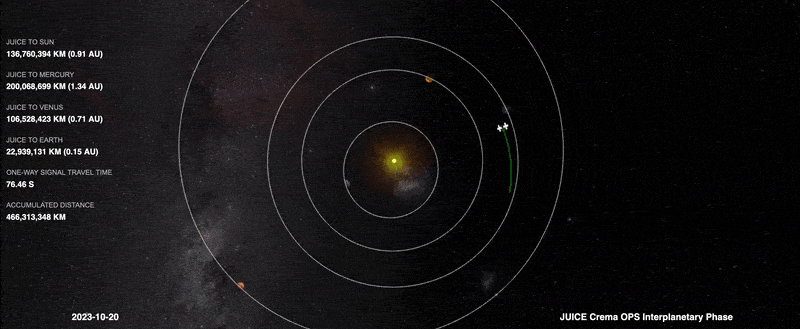20.09.2023

In brief
At their closest point in orbit, Earth and Jupiter are separated by almost 600 million kilometres. At the time of writing, five months after launch, Juice has already travelled 370 million kilometres, yet in time it’s only 5% of the way there. Why is it taking sooo long?
The answer depends on a variety of factors that flight dynamics experts at ESA’s Mission Control know well, from the amount fuel used to the power of the rocket, mass of a spacecraft and geometry of the planets.
Based on this, ESA's flight dynamics experts design a route. The world of orbital mechanics is a counterintuitive place, but with a bit of patience and a lot of planning it allows us to do a great deal of science with just a little fuel, as we’ll explain.
In-depth
Straight lines in space? Massive waste of energy
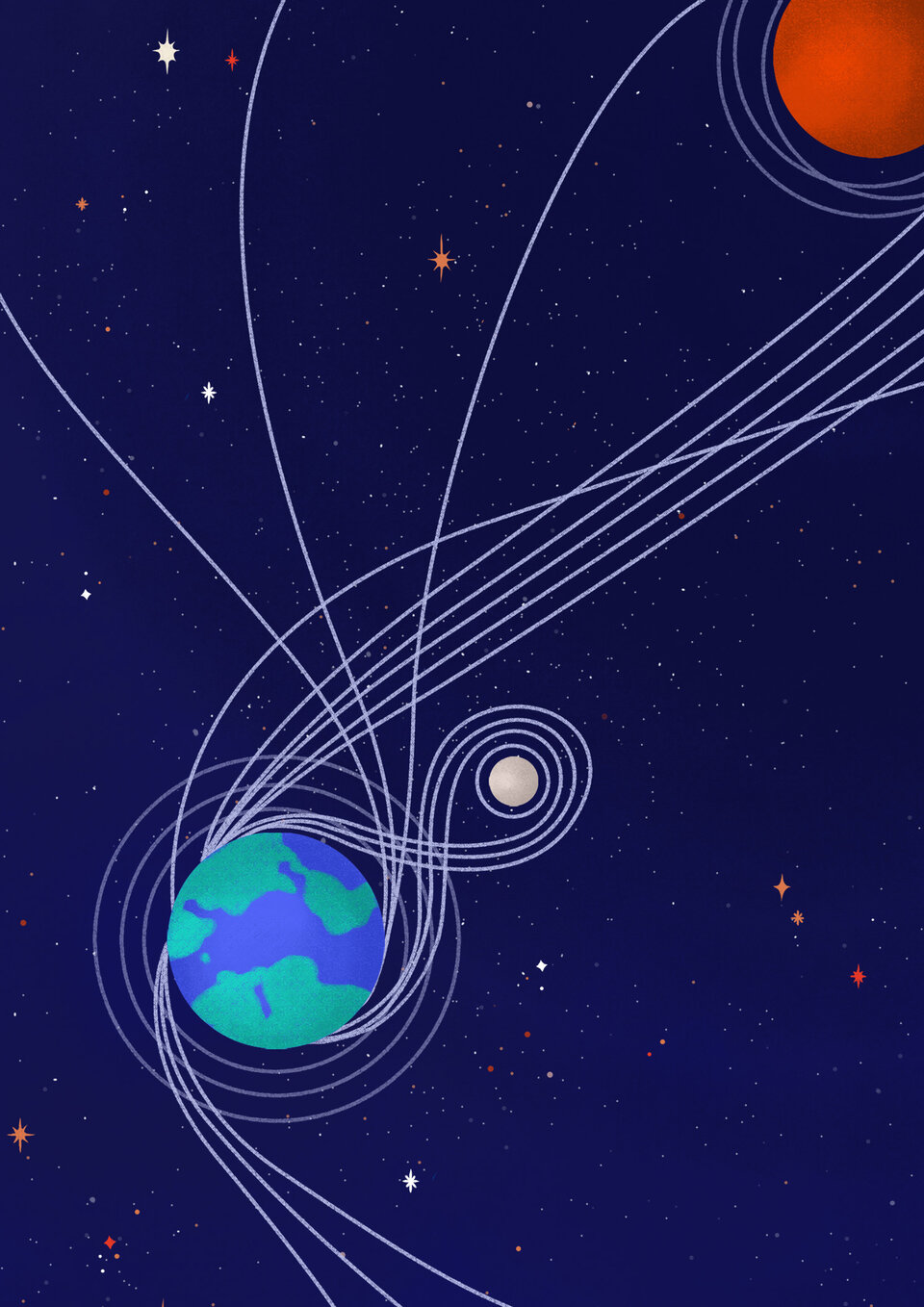
Track the motion of planets and moons and stars and galaxies, and you’ll see they’re always in motion around another object. When a mission launches, it doesn’t leap from a still Earth but off a planet zooming at about 30 km/s around the Sun.
As such, a spacecraft launched from Earth already has a great deal of ‘orbital energy’ – the only unit that matters when determining the size of an orbit around a central body. Just after launch, a spacecraft is in more or less the same orbit as our planet is around the Sun.
To break free from this orbit and fly in the shortest possible straight line from Earth to Jupiter, would need a big rocket and a lot of fuel. But it can be done. The next problem is, you’d then need even more fuel to brake and go into orbit around Jupiter and not zip right past it.
Targeting empty space
Jupiter and Earth are always moving with respect to each other. At their farthest apart, on opposite sides of the Sun, they are separated by 968 million kilometres.. The shortest distance between the two planets is when Earth and Jupiter are on the same side of the Sun with just under 600 million kilometres between them. But they’re in this position just for a moment before the distance grows again, never remaining at a constant distance.

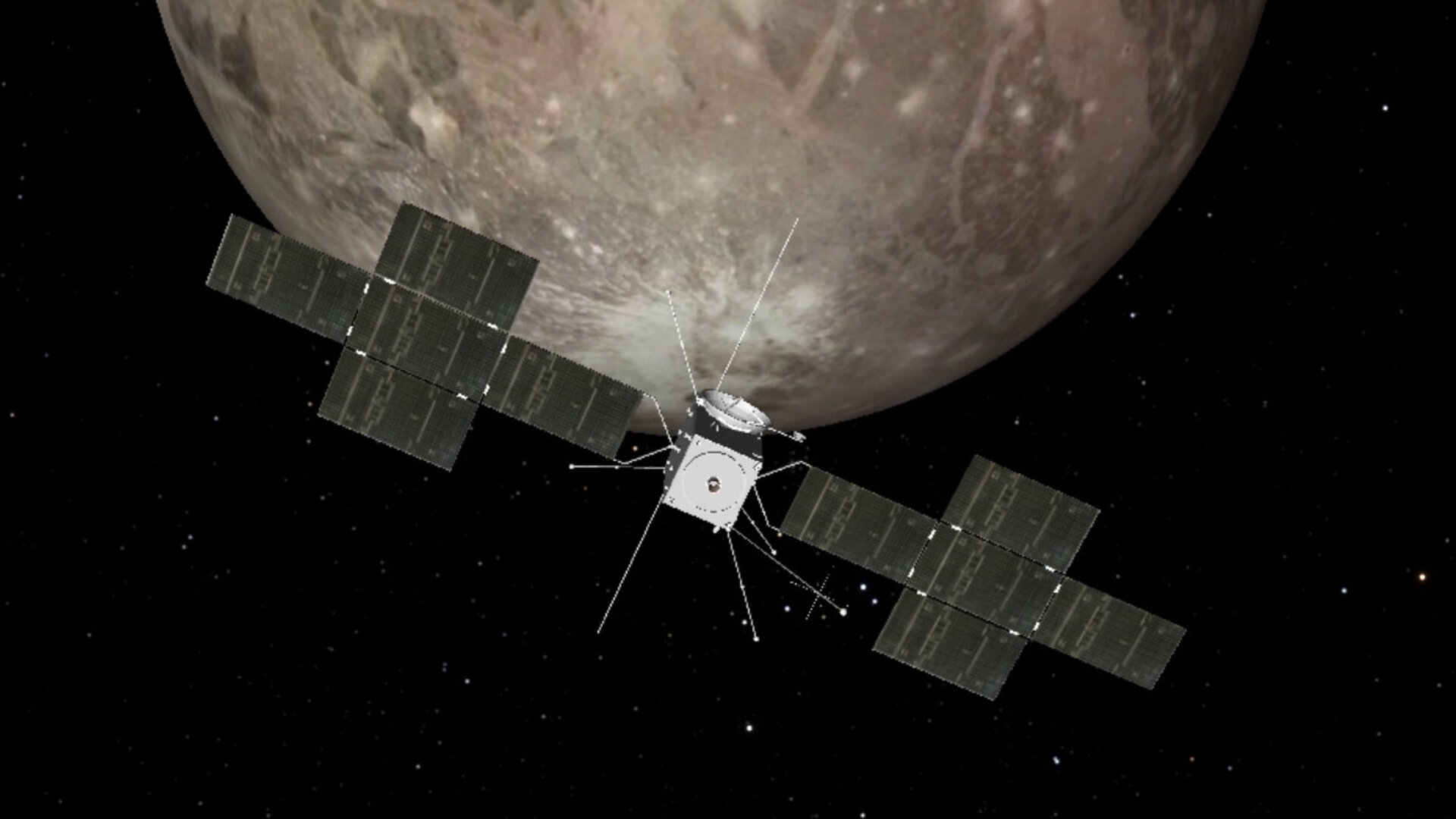
Access the video
The planets are all moving at different rates in their orbits around the Sun. Imagine throwing a ball at a moving target from a moving vehicle. Engineers must calculate the ideal time to make the jump on a circular path from Earth’s orbit to where Jupiter will be when the spacecraft arrives, not where it is when the spacecraft leaves Earth.
So, assuming we have the most powerful launcher available, and we launch on the shortest trajectory at the right time when the planets are aligned correctly, how long would it take?
Early space missions, such as the Voyager and Pioneer probes, made the journey in less than two years, and the fastest any object has travelled to Jupiter was the New Horizons mission. Launched on 19 January 2006, New Horizons made its closest approach to Jupiter on 28 February 2007, taking a little over a year to reach the planet. All these missions continued onwards, excellent examples to determine how long it takes for a Jupiter flyby on the way to somewhere else.
The longer the stay, the slower the approach
To get into orbit around the huge planet to study it from all sides and over time, perhaps even get into orbit around one of its moons – a Juice ‘first’ – you’ll need to lose some energy. This ‘deceleration’ will require a lot of fuel for a large orbit insertion manoeuvre. If you don’t want to launch with vast amounts of fuel, you take the scenic route, with a transfer duration of 2.5 years.
This is where we see the mass of the spacecraft as a crucial factor in determining the time it takes to get anywhere. Engineers need to control the spacecraft's mass, balancing the amount of fuel with the instruments it needs to carry to complete its mission. The more mass the spacecraft has, the more fuel it needs to carry, which increases its weight and makes it more difficult to launch.
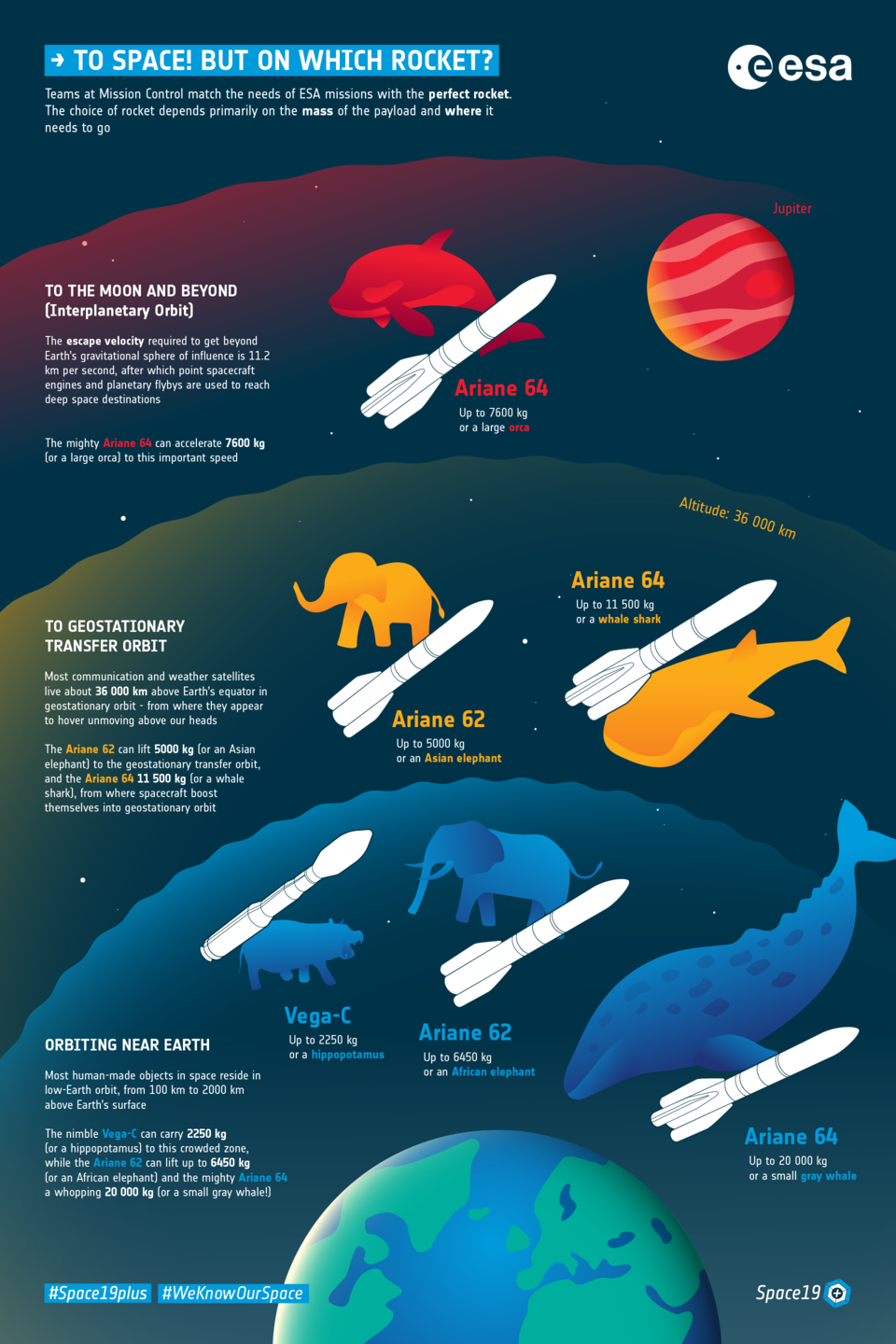
And this is where the launching rocket's performance comes in. The spacecraft needs to be launched with sufficient velocity to escape Earth's gravity and be flung on its way to the outer Solar System. The better the shove, the easier the trip.
Juice is one of the heaviest interplanetary probes ever launched, at just over 6000 kg, with the largest suite of scientific instruments ever flown to Jupiter. Even the massive boost from the Ariane 5 heavy-lift rocket wasn’t enough to send Juice directly there in a couple of years.
Therefore, missions such as Juice and Europa Clipper, or like Galileo and Juno in the past, have to make use of ‘gravity-assist’ or ‘flyby’ manoeuvres to pick up extra speed. The more powerful the rocket, the shorter the transfer.
Trading energy with the Solar System
Pluto, at the edge of the Solar System, travels in a much larger orbit than Mercury, the innermost planet. Although Pluto moves more slowly with respect to the Sun, its orbital energy is far, far greater than Mercury’s.
To get a spacecraft into orbit around another planet, we must match its orbital energy. When BepiColombo was launched, its orbital energy was the same as Earth’s. It had to lose energy to fall closer to the centre of the Solar System and did so by shedding excess orbital energy by flying close to neighbouring planets.
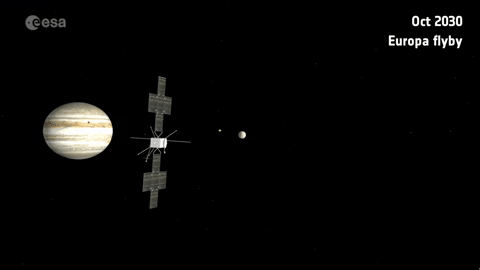
The same works in reverse to voyage to the outer Solar System. To get into a larger orbit, farther from the Sun, Juice is on a path that will let it steal orbital energy from Earth, Venus and Mars.
Depending on the relative direction of motion of the planet and the spacecraft, a gravity assist can either speed up, slow down or change the direction of the mission. (The spacecraft also deflects the planet, but by such a miniscule amount as to be insignificant. Nonetheless, Newton’s third law of motion has been preserved: ‘To every action there is an equal and opposite reaction’.)
Juice will use series of flybys of Earth, the Earth-Moon system and Venus to set it on course for its July 2031 rendezvous in the jovian system.
Orbit on a knife edge
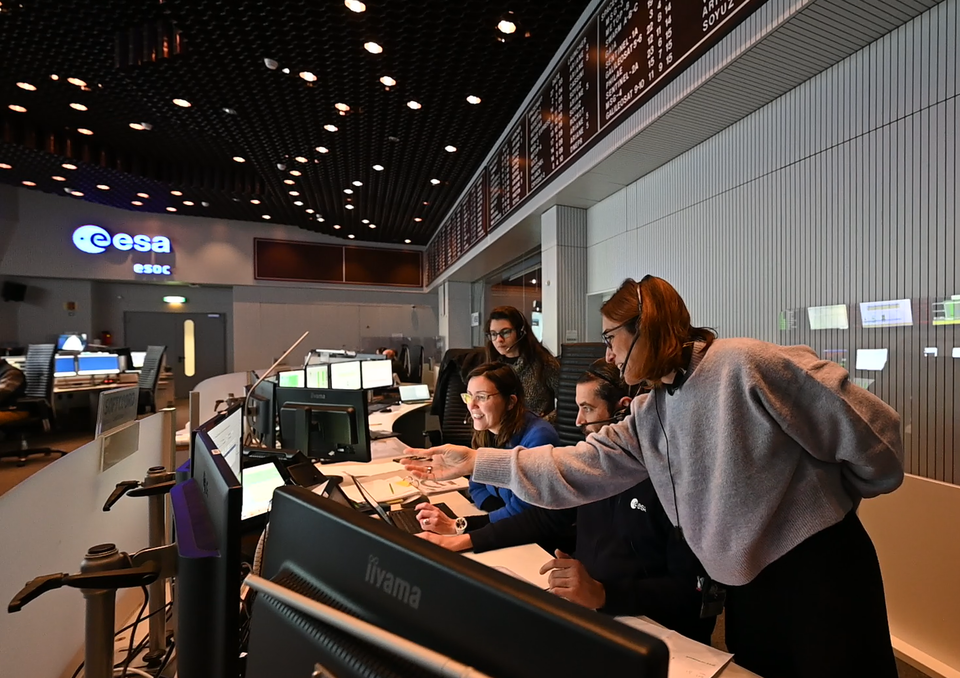
The most challenging part for the ESA’s flight control team comes when Juice finally arrives at Jupiter in 2031 and during its tour of Jupiter’s planetary system.
Juice’s challenging trajectory involves multiple gravity assists on the way to Jupiter – including the first ever Lunar-Earth flyby – and, once there, an impressive 35 flybys of its Galilean moons Europa, Ganymede and Callisto. The final focus will be on Ganymede, making Juice the first spacecraft ever to orbit a moon other than our own.
The single most important manoeuvre that teams at ESA's mission control in Germany will oversee, will be the slowing down of Juice by about 1 km/s only 13 hours after a Ganymede gravity assist, and ‘taking the exit’ to enter the Jupiter system, inserting the spacecraft into orbit around the gas giant.

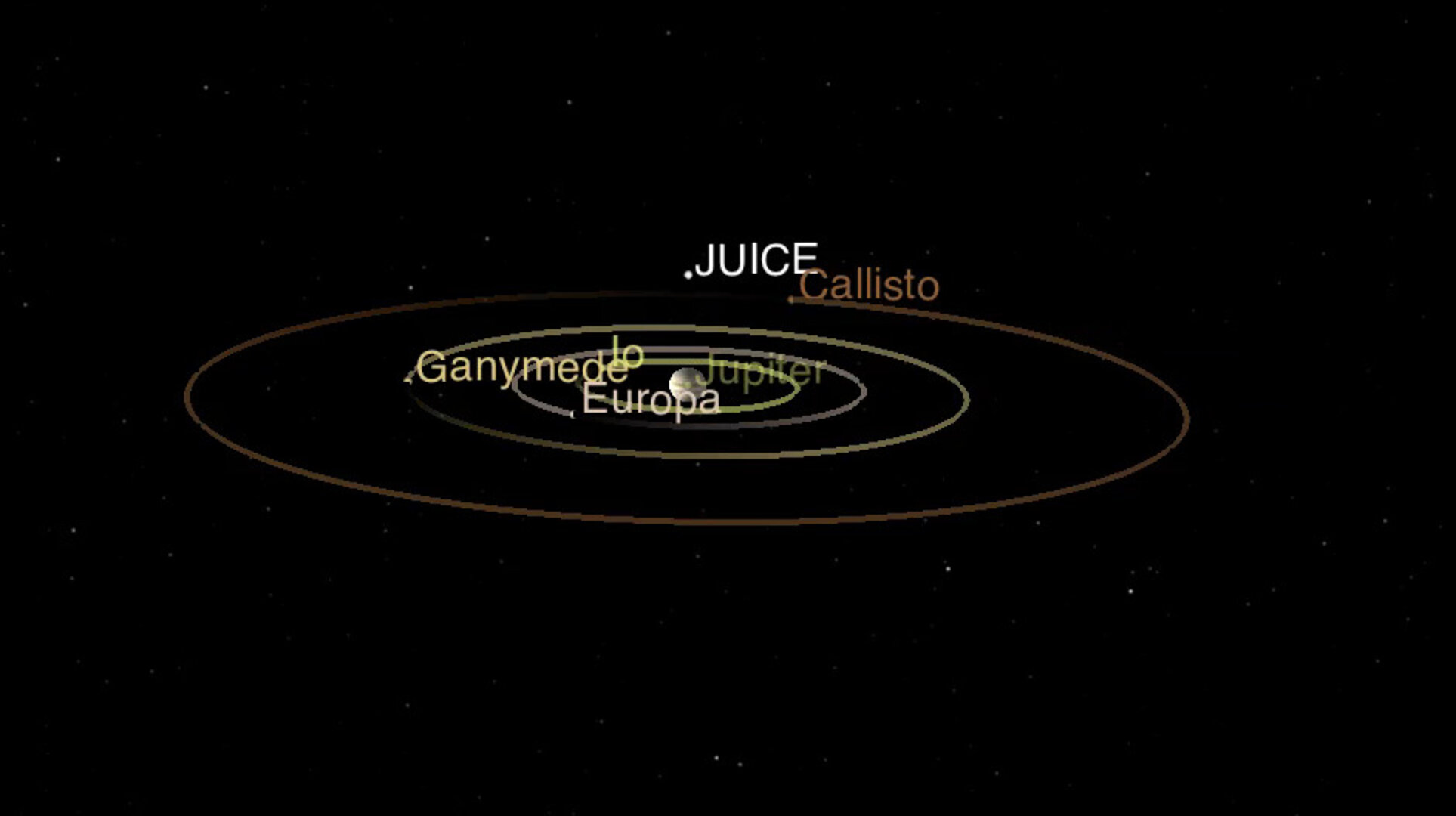
Access the video
Getting into orbit around another celestial body is hard. A spacecraft must approach with the perfect speed, from a precise angle, then execute a vital, big manoeuvre at just the right moment, in a specific direction and of the correct size.
Approaching too fast or slow, too shallow or steep, or manoeuvring at the wrong time, with the wrong amount or direction and you’re lost in space. Or you’re far enough off track that it will take a lot – perhaps too much – fuel to correct your path.
Juice will get close to Jupiter’s moons, trading energy with them that they’ve held onto for billions of years, to get a view of these environments like never before. Could there be life under the frozen oceans of Ganymede, Callisto or Europa? What can we learn about the formation of planets and moons throughout the Universe? Through the wonder of flight dynamics, by trading energy with the Universe, we will soon(ish) find out.
Follow @ESAJuiceBar on Twitter/X for updates on Juice’s progress to Jupiter, @ESA_Juice for all the latest about the mission, and @esaoperations for news from ESA’s Mission Control.
Quelle: ESA
----
Update: 19.11.2023
.
Juice burns hard towards first-ever Earth-Moon flyby

In brief
On 17 November 2023, ESA’s Juice spacecraft carried out one of the largest and most important manoeuvres in its eight-year journey to Jupiter.
Using its main engine, Juice changed its orbit around the Sun to put itself on the correct trajectory for next summer’s Earth-Moon double gravity assist – the first of its kind.
The manoeuvre lasted 43 minutes and burned almost 10% of the spacecraft’s entire fuel reserve. It’s the first part of a two-part manoeuvre that could mark the final time that Juice’s main engine is used until its arrival in the Jupiter system in 2031.
In-depth
Mission to Jupiter picks up speed

ESA’s Jupiter Icy Moons Explorer (Juice) launched from Europe’s spaceport in French Guiana on 14 April 2023.
It’s on a mission to make detailed observations of the giant gas planet and its three large, ocean-bearing moons – Ganymede, Callisto and Europa.
But Juice won’t begin its investigations into the nature and possible habitability of the Jupiter system until its arrival in 2031.
Why does it take so long to get to Jupiter? Well, the short answer is that its less to do with the distance between Earth and Jupiter and more to do with fighting the Sun’s massive gravitational pull as you venture outwards through the Solar System.
Missions to the giant gas planets, such as Juice, Europa Clipper, Galileo or Juno, would be little more than giant fuel tanks if they had to store all the energy needed to overcome the Sun’s gravity by themselves.
Instead, they make use of ‘gravity-assist’ or ‘flyby’ manoeuvres to gain energy by swinging through the strong gravitational fields of various planets on the way.
Shooting for the Moon

Juice’s first boost will come from its home planet, when it returns to Earth in August 2024, more than one year after launch.
In fact, in a first-of-its-kind flyby, Juice will first pass by the Moon to give it an extra kick and make the flyby of Earth that takes place 1.5 days later even more effective.
But even with this extra boost, to get the most out of the gravity assist, Juice has to arrive at the Earth-Moon system at precisely the correct time, at the correct speed and travelling in the correct direction.
That’s where today’s manoeuvre comes in.
On 17 November, at 16:10 (CET), Juice’s main engine performed a burn that lasted roughly 43 minutes.
“This manoeuvre used up roughly 363 kg of fuel – or almost exactly 10% of the 3650kg of fuel that Juice launched with,” says Julia Schwartz, Flight Dynamics Engineer at ESA’s ESOC mission control centre in Germany.
This is Juice’s largest manoeuvre so far. Until today, Juice had only used roughly 10 kg of fuel – mostly as part of a series of short burns used to help free its stuck RIME antenna.
“It was the first part of a two-part manoeuvre to put Juice on the correct trajectory for next summer’s encounter with Earth and the Moon. This first burn did 95% of the work, changing Juice’s velocity by almost 200 m/s,” adds Julia.
“Juice is one of the heaviest interplanetary spacecraft ever launched, with a total mass of around 6000 kg, so it took a lot of force and a lot of fuel to achieve this.”
“In a few weeks, once we’ve analysed Juice’s new orbit, we will carry out the second, much smaller second part of the manoeuvre. Splitting the manoeuvre into two parts allows us to use the second firing of the engine to iron out any inaccuracies of the first.”
An additional, much smaller manoeuvre using Juice’s smaller thrusters may be carried out in May 2024 for the final fine tuning during the approach to Earth.
Last use of the main engine until 2031
For a mission on an eight-year journey, burning 10% of your fuel reserve in just 43 minutes may seem crazy. But investing all that fuel now will pay off for years to come.
“If all goes well with both parts of this manoeuvre, we likely won’t need to use the main engine again until we enter orbit around Jupiter in 2031,” says Ignacio Tanco, Juice Spacecraft Operations Manager. “For small trajectory corrections between now and then, we will use Juice’s smaller thrusters.”
But that doesn’t mean nothing interesting will happen between now and Juice’s arrival at Jupiter. Quite the opposite, the journey is interesting because it allows Juice to get all the way to Jupiter without firing of its main engine again, reducing the amount of fuel the spacecraft needs and allowing it to be packed full of scientific instruments.
After the Earth-Moon double flyby of 2024 (knows as a Lunar-Earth Gravity Assist; LEGA), Juice will first make one flyby of Venus in 2025 and two further flybys of Earth in 2026 and 2029 (both without the additional boost from the Moon).
“Today’s manoeuvre will ensure Juice arrives at the Earth-Moon system at the right time next year for the double flyby,” adds Ignacio.
“And, thanks to the clever trajectory designed by our Mission Analysis team, that flyby will line it up almost perfectly for all of the others, without us having to fire the main engine again.”
With each flyby, the spacecraft will gain more energy than could be achieved by burning a reasonable amount of fuel – energy that will help it climb towards Jupiter against the pull of the Sun’s gravity.
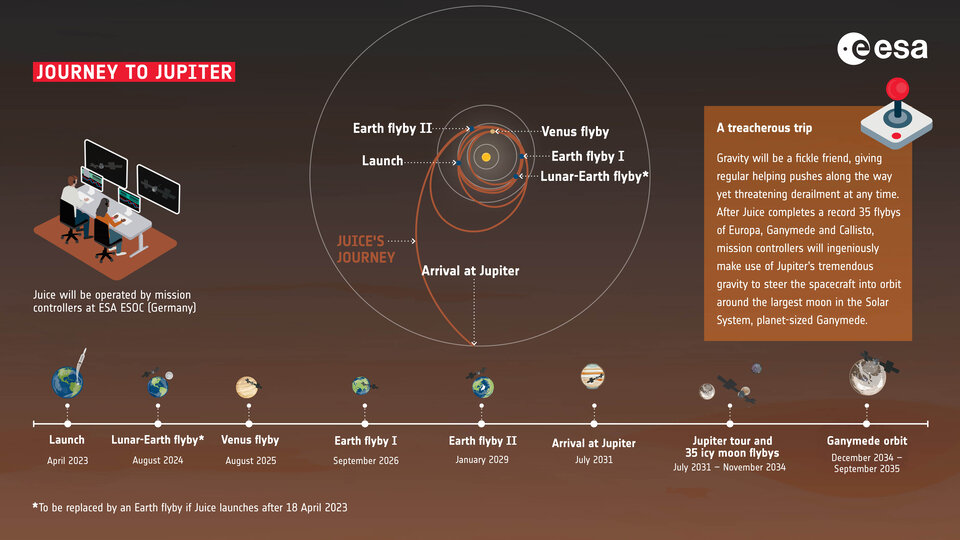
“It was very important that we carry out this manoeuvre today. Otherwise, the cost – how much fuel we would need to burn to reach the new orbit we need – would begin to shoot up dramatically,” says Ignacio.
Today’s burn also gave the teams the opportunity to make sure Juice’s main engine is working correctly. It was first tested shortly after launch, but it until today, it hadn’t been used for such a big manoeuvre out in deep space.
“There were some things that we couldn’t test before now. For example, we only had an estimate for how the liquid in the fuel tanks will move around as the spacecraft accelerates. This is very important to know precisely, because if the fuel behaves different to how we expect, it could cause the spacecraft to drift off course during the burn. So, we are monitoring closely.”
Next stop: Jupiter!
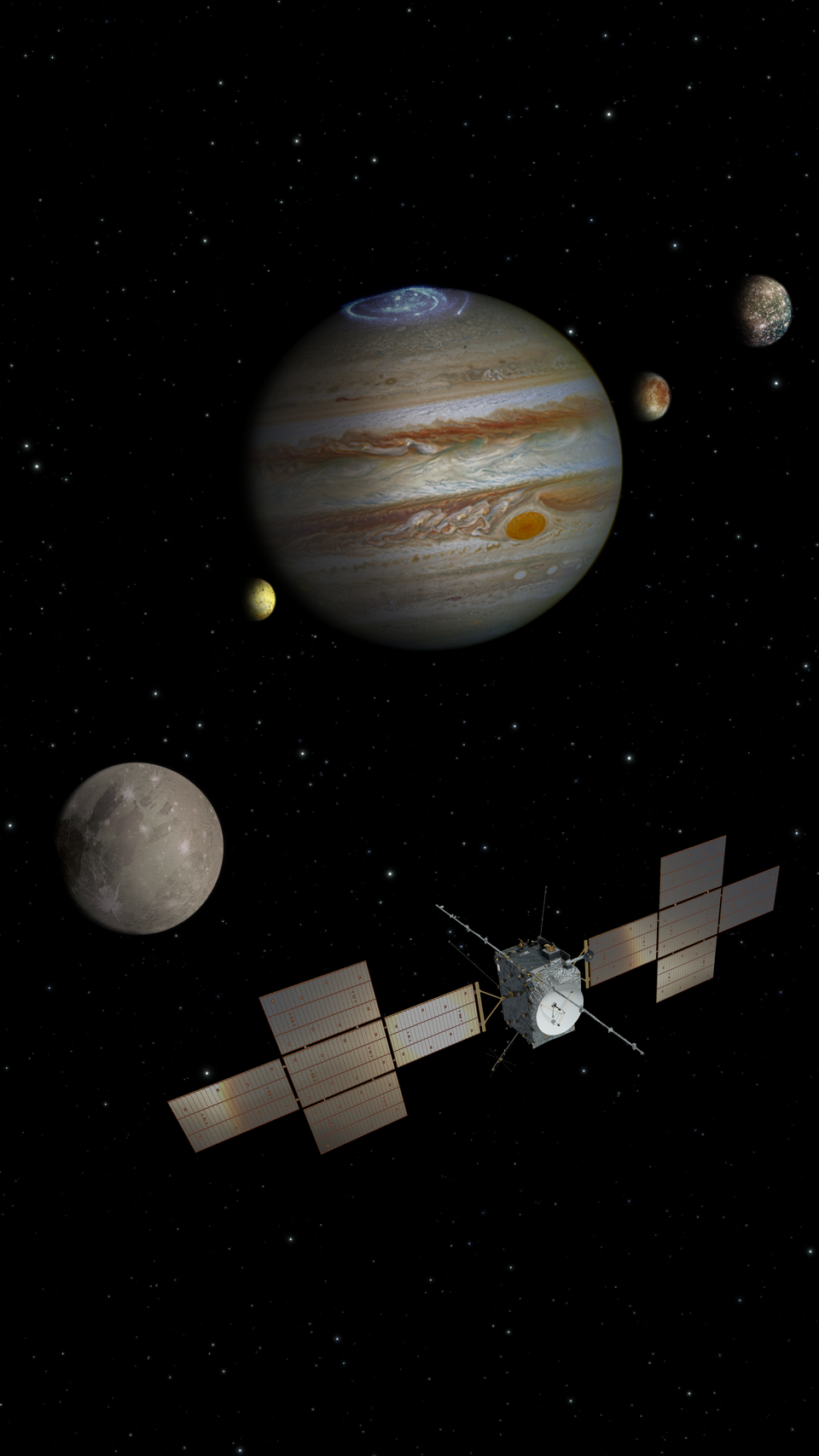
The next time that Juice will absolutely have to fire its main engine is during its ‘Jupiter Orbit Insertion’ in 2031. This is the single most important manoeuvre that the teams at ESOC will oversee.
Just 13 hours after swinging by Ganymede and entering the Jupiter system, the spacecraft will need to slow down by about 1 km/s – five times the change in velocity achieved today.
“That makes today’s manoeuvre also an important test for Jupiter insertion – the sooner we know if we have any issues with the main engine, the better,” says Ignacio.
Once in orbit around the gas giant, Juice can begin its exploration of the Jupiter system. Teams at ESOC will steer Juice through a series of 35 flybys of the ocean moons. Where once flybys were a yearly occurrence, at Jupiter they will be carried out as often as once every two weeks.
These close-ups of the icy moons will allow the spacecraft and scientists on Earth to gather the data needed to better understand these mysterious alien worlds.
Juice – up to date and behind the scenes
Want to know more about how Juice was imagined, designed, constructed and launched? The feature-length film, ‘The Making of Juice’, premieres on ESA’s YouTube channel at 18:00 CET on 23 November 2023.
Quelle: ESA
----
Update: 29.11.2023
.
'The Making of JUICE' film documents how scientists built a Jupiter-bound spacecraft against the odds
The two-hour documentary is a fascinating look into the science, the engineering, and the challenges of constructing Europe’s biggest mission yet: The Jupiter Icy Moons Explorer.

Documentary movie poster for ‘The making of Juice’ (Image credit: ESA
The European Space Agency's Jupiter Icy Moons Explorer (JUICE), which blasted off for the Jovian system on April 14, has now got its very own documentary chronicling the latter stages of the mission's development, capturing the challenges of assembling a spacecraft during a pandemic and the exultation of a tricky launch.
The two-hour documentary, simply called "The Making of JUICE," is the brainchild of JUICE Project Manager Giuseppe Sarri and Project Scientist Olivier Witasse. It's currently available for free on the European Space Agency's YouTube channel.
"We came up with the idea of filming key moments in the final stages of the development and testing of JUICE," said Sarri in a statement. In March 2019, JUICE had just successfully passed through its Critical Design Review and received the go-ahead to integrate all the instruments onto the craft and begin testing it. "It seemed just the right moment to start recording our progress, with the idea to capture not only the technical aspects but, above all, the human elements of this very challenging endeavor."
The duo teamed up with planetary scientist Maarten Roos, also a documentary filmmaker, who spent the next three to four years interviewing the mission's scientists all over Europe. Roos also meticulously followed the building and testing of the spacecraft in Airbus' clean rooms in Germany.
JUICE was an important subject for this documentary because it is considered the European Space Agency's biggest and most ambitious mission yet. The spacecraft is voyaging to Jupiter to study three of the gas giants' famous Galilean moons — the icy worlds of Europa, Ganymede and Callisto (the odd moon left out being the fiery, volcanic Io). JUICE will perform two fly-bys of Europa, 12 fly-bys of Ganymede and 21 of Callisto before settling into orbit around Ganymede, which is the largest moon in the solar system, bigger even than the planet Mercury.
Jupiter's icy moons are of great interest because at least two of them, Europa and Ganymede — and possibly all three — are believed to harbor subsurface oceans that could potentially have conditions suitable for primitive life.
It's a tremendously exciting mission, but also a challenging one. On that note, filming was challenging, too.
Not long after production on the film began, the COVID-19 pandemic struck, resulting in the mission getting delayed by a year. To keep the public abreast of how the mission was coming along during this extended period, Roos made some of his footage available early in the form of a dozen five-minute shorts and 17 one-minute snippets prior to JUICE’s successful blast-off from French Guiana.
Then, following the launch, Roos edited all the footage to produce the final cut of "The Making of JUICE," which is the final product that premiered on ESA's YouTube channel on November 23rd.
"It is an entertaining movie, easy to watch, telling the story of JUICE from initial conception to the start of its voyage to Jupiter," said Sarri. "And it shows that behind all great projects are great people.”
Among these great people featured in the film are the mission's primary scientists, as well as the engineers and technicians who built, tested and launched the spacecraft itself. We meet Michel Blanc of the Institut de Recherche en Astrophysique et Planétologie in France, for instance, who constructed the original plan for what ultimately became JUICE. The film speaks to Michelle Dougherty of Imperial College London as well, who is the science lead on JUICE's magnetometer instrument and who recalls how the mission was initially a joint venture with NASA, and had to be hurriedly redesigned in just 3 months when NASA dropped out.
We also meet the engineers who don't normally get the limelight. For instance Andrea Hertel,the only woman in the mechanical engineering team at Airbus who worked on JUICE, talks about how the spacecraft is strongly magnetic. This meant the team had to be very careful with what tools they used around it — even a bunch of car keys could potentially have been a problem, had they gotten too close and become attached to the spacecraft's components.
We also catch a glimpse of the opening of the spacecraft's solar panel wings as they undergo testing in the clean room. We learn that solar illumination is so low at Jupiter, between 25 and 30 times less than what Earth experiences, that the solar panels can only provide 900 watts of energy. That's barely enough to power a hairdryer. Therefore, all the functionality on the spacecraft has to be designed to operate with this energy constraint.
Beyond that, we also see first-hand how the COVID-19 pandemic affected the mission's development. Interviewed a few months before the pandemic hit, Sarri talks about how launch was scheduled for May 2022, to take advantage of a number of carefully planned fly-bys of the inner planets to gain the gravitational boost required to fling the spacecraft to Jupiter.
"For us it is very important to be on time," Sarri says in the film, but the pandemic necessitated a significant change in plans, including launch a year later and an extra year of travel time to Jupiter, from 7 to 8 years with arrival now falling in 2031. The film shows how the scientists and engineers kept things moving on the mission during the pandemic nonetheless, with teams of technicians and engineers forming "bubbles" and working in separate shifts so as to be kept apart and limit the spread of the virus .
All in all, "The Making of JUICE" is a terrific behind-the-scenes look at the challenges inherent in building and sending an interplanetary mission into space. During a pandemic as well, in this case.
The film ends with the successful launch of JUICE and the exhilaration of the scientists and engineers. Perhaps we’ll get a sequel in ten years once JUICE has arrived at Jupiter and begun studying the icy moons.
You can watch "The Making of JUICE" for free on the European Space Agency's YouTube channel.
Quelle: SC

